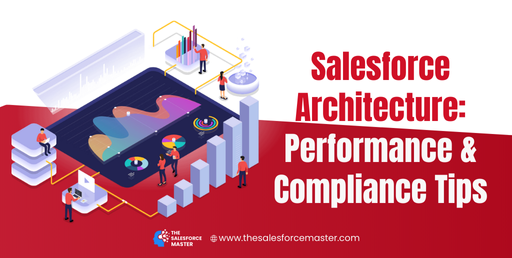
Salesforce Architecture: Performance & Compliance Tips
A robust Salesforce architecture ensures optimal performance and maintains regulatory compliance. By integrating best practices, architects can streamline operations and enhance user experiences. Here are practical insights to boost performance and compliance.
Optimizing Performance in Salesforce Architecture
Performance in Salesforce hinges on several key factors, including data design, code efficiency, and system configurations.
Efficient Data Management:
Organize data thoughtfully. Limit the number of records queried at once and use indexed fields. Archiving older records reduces load times, improving Salesforce Login experiences. Also, regularly clean redundant data to maintain database health.
Optimize Custom Code:
Apex code should follow best practices. Use efficient loops, avoid SOQL queries inside loops, and bulkify operations. Leverage Salesforce Marketing Cloud for automating marketing tasks to free up system resources.
Leverage Caching Mechanisms:
Utilize platform caching to store frequently accessed data. This minimizes the need for repeated calculations or queries, enhancing performance. Additionally, implement Content Delivery Network (CDN) caching to reduce load times for static resources.

Ensuring Compliance in Salesforce Implementations
Compliance is critical, particularly for sectors handling sensitive information like finance and healthcare. Salesforce offers tools and best practices to meet industry standards.
Data Governance Policies:
Establish clear data governance policies. Define who can access, modify, and delete data. Implement field-level security to protect sensitive information. Salesforce Marketer benefits from compliant data handling practices, ensuring marketing campaigns meet privacy regulations.
Audit Trails and Monitoring:
Enable audit trails to track data changes. This helps in understanding who accessed or altered data, providing accountability. Salesforce’s Event Monitoring provides detailed insights into user activity. Using these tools ensures both security and compliance.
Adopt Regulatory Standards:
Ensure your Salesforce environment aligns with standards like GDPR, HIPAA, or SOC 2. Utilize Salesforce Shield for encryption and monitoring. This adds an extra layer of security, particularly important for marketing campaigns managed by Salesforce Marketing Cloud.
Key Tools for Enhancing Performance and Compliance
Salesforce offers various tools to maintain performance and compliance. Implementing these tools effectively ensures your system remains reliable and secure.
Salesforce Optimizer:
This tool analyzes your system’s health and suggests improvements. It identifies performance bottlenecks and compliance issues. Regular use can maintain system efficiency and highlight areas needing attention.
Salesforce Marketing Cloud Integration:
Integrate Salesforce Marketing Cloud to streamline marketing processes and ensure data consistency. It automates workflows, reducing manual errors and improving compliance with industry standards.
Salesforce Login Security:
Implement multi-factor authentication (MFA) for all users. This step strengthens system access control, reducing unauthorized login risks. Regularly review login activity reports to identify anomalies.
Custom Metadata and Settings:
Use custom metadata types to manage configurations without changing code. This simplifies updates and ensures compliance with configuration standards. Custom settings can streamline Salesforce Marketing Cloud operations, improving data handling efficiency.
Conclusion
A well-architected Salesforce system balances performance and compliance seamlessly. By optimizing data management, securing logins, and aligning with regulatory standards, organizations enhance their operational efficiency. Utilizing Salesforce tools like Optimizer and Marketing Cloud ensures sustained performance while meeting compliance goals. With these strategies, Salesforce architects can build resilient, high-performing systems.


